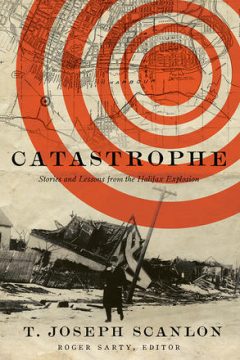It took an advertising copywriter, Walter Lord, to discover the Titanic in 1955. Of course everyone knew of the big ship that hit an iceberg, but it was Lord who fashioned the story into a narrative he called A Night To Remember. The non-fiction bestseller was a modest 208 pages yet inspired generations of Titanic-themed novels, films and stage plays based on Lord’s simple premise: There is nothing more interesting than interesting people in trouble.
Similarly ex-newspaperman Joe Scanlon and historian Roger Sarty of Wilfrid Laurier University discover the Halifax Explosion and fashion it into a compelling tale of humanity in Catastrophe: Stories And Lessons From The Halifax Explosion. Everyone knows about the 1917 harbour collision of a munitions ship that blew the city sky high. The drama is not in the unsafe transportation of dangerous goods any more than Titanic is illustrative of bad seamanship. It’s the people who make it an indelible story.
At 9:04 am on December 6, 1917, a calm, clear morning, the French munitions ship Mont-Blanc collided with a Norwegian steamer in Halifax harbour. It sparked a fire that quickly spread to the cargo.
Abandoned by her crew, the Mont-Blanc drifted towards the Halifax docks as munitions smoked and sputtered like a box of fireworks, then ignited into a mammoth explosion that flattened the city and killed 1,963 people. It was all over in about twenty minutes.
There was a “blinding sheet of fire about a mile high in the air,” eyewitnesses recalled. The explosion was heard fifty miles out to sea. Others remembered seeing the big funnel from the Mont-Blanc catapulting through the sky.
Captain Aimé Le Médec was on his maiden voyage as skipper of the munitions ship. He briefly considered going down with the Mont-Blanc but instead rowed away, not bothering to hoist a signal flag to alert the city his steamship was packed with 225 tons of TNT. Later he was charged with criminal negligence but never went to trial.
“I saw the Frenchies’ port lifeboat in the water,” an eyewitness remembered. “They were pulling past the stern of their ship and were heading for the other shore. Two men were standing up in the boat shouting. What they were saying I don’t know, because I cannot speak French.”
The explosion flattened the Acadia Sugar Refinery, Hillis Foundry and the Starr Street Synagogue. Twenty-seven of forty children at the Protestant orphanage perished in the flames. A survivor recalled seeing children cut about the neck by flying glass: “It seemed just as if a keen knife-edge had slashed each little throat.”
Annie Chapman, a railwayman’s wife, was at home with her baby when the house collapsed and she awoke to the infant’s cries from the rubble. “I dug like a crazy woman towards where the cry seemed to come,” said Chapman. “I dug and pulled at the beams and boards that had fallen like a pile of kindling wood. I lifted boards I never could have lifted at any other time and then came to the plaster. I got down on my knees and put the whole length of my arm under the plaster and felt the warm little head of my baby.” Both survived.
Deputy Mayor Henry Colwell, a haberdasher, on hearing the explosion sprinted from his store to City Hall, formed the Halifax Relief Commission within 120 minutes and quickly arranged food and coal deliveries for survivors. The city was hit with a blizzard the following day. Colwell’s descendants still mind the store on Water Street.
Catastrophe: Stories And Lessons From The Halifax Explosion is first rate. How unfortunate that author Joe Scanlon, a former Toronto Star reporter on Parliament Hill, did not live to see it published. Scanlon died of a heart attack nine years ago at 83.
By Holly Doan
Catastrophe: Stories and Lessons from the Halifax Explosion, by T. Joseph Scanlon; Roger Sarty, editor; Wilfrid Laurier University Press; 400 pages; ISBN 9781-7711-23716; $39.99






